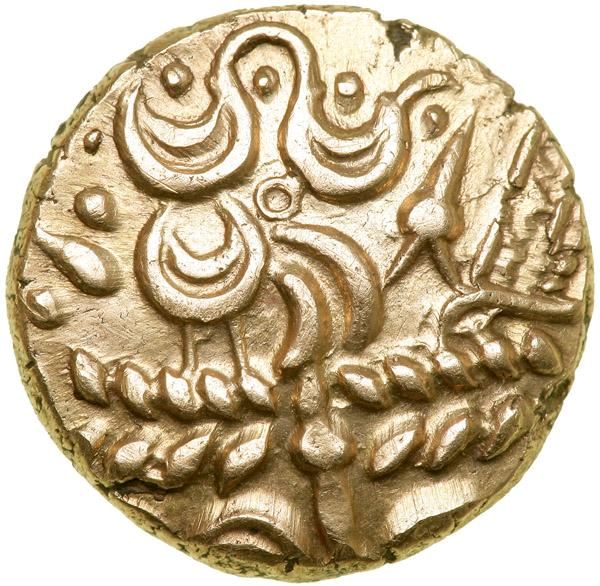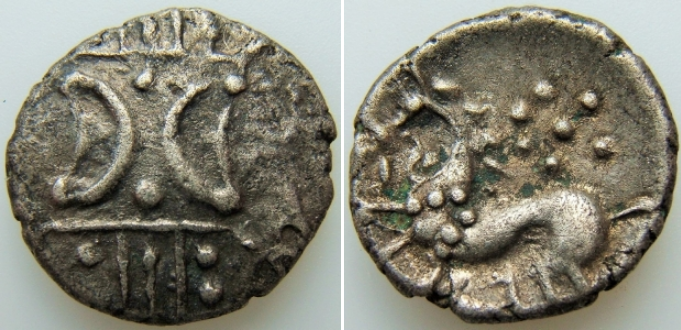The territory inhabited by the Britons was composed of numerous ever-changing areas controlled by Brittonic tribes. The extent of their territory before and during the Roman period is unclear, but is generally believed to include the whole of the island of Great Britain, at least as far north as the Clyde-Forth isthmus, and if the Picts are included the entirety of Great Britain.
British Celtic coin designs were, like coin designs of the Celts elsewhere, initially local copies of designs struck elsewhere. The first homegrown British Celtic coins were bronze coins copying designs from Massalia. Later on, original designs were added to the more and more stylized and celticized designs, until production of tribal coinage more or less ceased completely following the invasion of Britain by Claudius in 43 AD.

(19).jpg)
Reverse: Disjointed horse left, with rectangular head, body of crescents, four vertical legs, three roughly horizontal lines for tail; pellet below; twelve pellets above
Die Orientation: 0 H
Weight: 2.99 g
(18).jpg)
Reverse: Stylised horse prancing right, with grain ear mane; [pelletal sun above], reversed S before, pellet triad, line of three pellets and [obscured monogram] below
Die Orientation: 9 H
Weight: 1.24 g
Before the Romans arrived Britain was shared by several Celtic tribes; the Iceni being centred on the Norfolk area (but also occupying surrounding parts of Suffolk and Cambridgeshire). The Iceni are probably best known as the tribe that, united with the Trinovantes (from the area north east of London), ran riot over Roman rule under their warrior queen Boudicca. This coin, whose Celtic name has never been discovered, is simply referred to as a ‘silver unit’. It is tiny at just 14mm diameter and weighing in at 1.24g. All of these coins weighed the same (1.25g); a standard which was maintained for over 100 years to an extremely small tolerance, an amazing techical achievement for the time. As with all Celtic coinage the design is somewhat abstract. On the obverse is an ornate pattern, resembling 2 C’s back to back across an ornate belt, with patterns around. This has been progressively derived from the hair & laurel head band of Apollo on Greek coins, whose face has since disappeared. The reverse shows a horse galloping towards the right, a dotted wheel above it’s back, and various dots around. The charioteer has disappeared, and what remains of the chariot is the wheel floating above. Some of the dots and symbols are not mere random decoration but part of a series of coded control marks, probably denoting the issuing mint and moneyer. The coins were struck on concave blanks which were only about two-thirds of the size of the dies, so the entire design is never seen on one specimen.

Reverse: Celticised horse left, 6 pellets on shoulder, floral pellets Sun above, ECEN (retrograde) below.
Die Orientation: 12 H
Weight: 1.09 g
